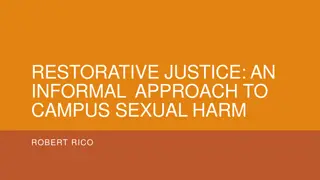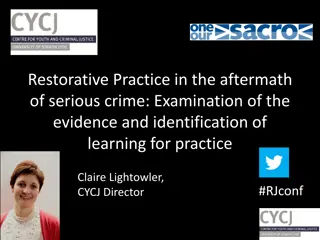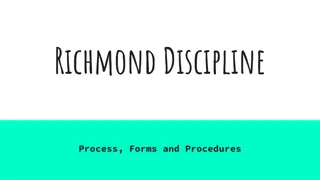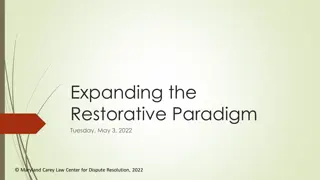Restorative School Culture: Making it Right in a School World of Wrongs
Former counselor Dr. Kim Davis leads Walnut Creek Campus in creating a restorative school culture focusing on relationships, responsibility, and healing. The school emphasizes collaborative problem solving, giving voice to victims and offenders, and fostering a sense of community and safety through restorative practices.
Download Presentation

Please find below an Image/Link to download the presentation.
The content on the website is provided AS IS for your information and personal use only. It may not be sold, licensed, or shared on other websites without obtaining consent from the author.If you encounter any issues during the download, it is possible that the publisher has removed the file from their server.
You are allowed to download the files provided on this website for personal or commercial use, subject to the condition that they are used lawfully. All files are the property of their respective owners.
The content on the website is provided AS IS for your information and personal use only. It may not be sold, licensed, or shared on other websites without obtaining consent from the author.
E N D
Presentation Transcript
Making it Right in a School World of Wrongs: Creating a Restorative School Culture Dr. Kim Davis, Principal Walnut Creek Campus West Des Moines School District 515-633-6480 davisk@wdmcs.org
Background About Me: Former counselor and am always trying to assess what the root of the problem behavior is. Walnut Creek Campus: Alternative High School in WDM What makes our school special? Staff members have a growth mindset/flexible/real Students trust us and want support. It is ok to struggle/make mistakes, etc.. and ask for help Families- We have a collaborative relationship and generally they welcome any/all assistance Twelve years ago we began a journey together
First, we learned about what restorative schools do (Amstutz and Mullet) 1. Focus primarily on relationships and secondarily on rules. They acknowledge that relationships are central to building community and build systems that address misbehavior and harm in a way that strengthens relationships. 2. Give a voice to the person harmed. 3. Give a voice to the person who caused the harm. 4. Seek to recognize the motivation driving the misbehavior. 5. Enhance a sense of responsibility to the community by engaging in collaborative problem solving. 6. Empower, change and grow. 7. Encourage responsibility by planning for restoration.
What We Have Implemented A systemic response to wrongdoing that emphasizes healing the wounds of victims, offenders and communities. We often ask, How can you make this right? We also ask, What part did you play in the situation? Restorative practices help students, staff, and families give and ask for support. Students are not only responsible for their own behavior, but they also help to address behavior in other students, staff and/or their family members. This fosters a sense of community as well as a strong sense of safety. We use: circles, conflict mediation, restitution, individual counseling sessions, mindset classes. We have a restorative culture, in general.
Why have a restorative school environment? *Provides a sense of community. Schools have become larger and more impersonal. Kids feel less and less connected to the school and to each other. It fosters a We are all in this together mindset. Kim D says, My kids will all feel safe here. School has to be the one safe place all kids can count on. The leader needs to set the tone. *Helps to teach self discipline and self-regulation. *Promotes effective conflict resolution and collaborative problem solving skills. *Helps misbehaving students deal with the harm they have caused to individuals and to the school community. Instead of doing something to people, this process works with people. This is re-integrative shaming (Brathwaite).
We do not want students and staff to feel like just another brick in the wall Student 1 Staff 1 Student 3 Staff 4 Student 5 Student 6 Staff7 Student 8 Staff 9 Student 10 Student 11
Helps to Support Students More Effectively That Have Had Trauma ACES-Adverse Childhood Experiences 1. Physical abuse 2. Verbal/psychological abuse 3. Sexual abuse 4. Physical neglect 5. Emotional neglect 6. Parent who has a substance abuse issue 7. Mother is/was a victim of domestic violence 8. A family member that is incarcerated 9. A family member diagnosed with a mental illness 10. The disappearance of a parent through divorce, death or abandonment
Takes Maslows Hierarchy Into Consideration Self Actualization Aesthetic Needs Need to Know and Understand Esteem Needs (competency) Love and Belonging (Acceptance) Safety Needs Physiological Needs (Hunger, Thirst, Bodily Comforts)
In general, I ask myself: What is the function of the behavior? What basic need is this person trying to meet? Once I figure that out, I can work with the person more effectively.
There are 5 basic needs: Belonging Power Fun Freedom Survival -William Glasser
The old methods are not effective with at-risk youth. When the horse dies get off! Because many of our students have experienced trauma, they might be on that lower rung of Maslow s and they may be trying to get their needs met in unhealthy ways, we need to be mindful of all of that in order to work with them more effectively.
Discipline Continuum (Amstutz and Mullet, 2005) Goal=Behavior Change Punishment: Consequences are selected without any meaningful connection between the misbehavior and the punishment. Consequences: Seeks to make the punishment fit the crime by linking natural or artificially connected consequences to the crime. Solutions: Seeks to find the function or purpose of the misbehavior and then develop a plan to replace the misbehavior with a positive behavior. Restoration: Looks at the needs of the misbehaving person and the person harmed.
Common Misperceptions This is too soft and does not change behavior! The kids get off too easily and are not accountable for their actions! Punishment will make them behave! Working in a restorative way is quick and easy
Good quotes to remember You have to give away power to get power. Ron Claassen When people feel zero, they act zero. -Sally Ogden Punishment does not equal accountability. -Ron Claassen Do I teach the kids the behavior I want or do I punish the behavior I see? -Betsy Geddes We need to model functional, not dysfunctional. Betsy Geddes
Abraham Maslow: If the only tool you have is a hammer, everything around you looks like a nail.
Relationships, Relationships, Relationships Most discipline issues in the school setting deal with relationships. Relationships are at the heart of most conflicts. It is all about making deposits so that when you need to make a withdraw, you can.
What does it teach students? External vs. Internal Locus of Control External (doing something to people) examples: You are suspended! I want this student punished for what they did! Internal (change comes from the inside) examples: What can I do to make it right? What did I do that caused this situation and what can I do differently next time?
There are still bottom lines when addressing matters of safety in a restorative school. In WDM, bottom line subjects would be: Weapons Illegal substance use/distribution Fighting But, even if the student has a punishment, there can still be an additional restorative component.
Why do schools stick with the same old punishment model? Quick Easy The only way they know how to discipline; it is familiar
Program Development Essentials: 1. Shared values *Who are we? *What do we believe? Can we support a restorative approach? *What do we want to accomplish? 2. Broad-based support and involvement *Claudia Henning and YJI *Superintendency *My staff 3. Time *Staff development time *Time built into the school day (conflict mediation/circles/individual counseling sessions/mindset classes)
How Do You Create a Positive School Culture? Restitution Circles Individual Counseling Sessions Mindset for Success Classes Conflict Mediation Positive School Culture
RJ Guiding Questions (Zehr): Who has been hurt? What are their needs? Whose obligations are they? What are the causes? Who has a stake in this? What is the appropriate process to involve stakeholders in an effort to put things right?
Conflict Mediation (Gold Card From Ron Classsen) 1. Person A describes how he/she experienced the problem, conflict, or injustice. 2. Person B summarizes what he/she heard. 3. They switch roles until the conflict is resolved. *A mediator is used until the parties are confident enough to use the process without one. 4. An agreement is made that both are comfortable with. 5. You can have all parties do an evaluation sheet.
Examples of Conflict Mediation: Staff/staff Student/staff Student/student Students/parents/staff
Circles Circles allow for the offender, the offended and the community to come together. There are different types of circles: 1. Check in/out 2. Support 3. Concern 4. Miscellaneous (used for many different situations and to address various issues)
Required Circle Components **See sheet for general outline and forms. A circle keeper. It is a good idea to have several trained people in your building who can facilitate. A talking piece. Time. Confidentiality statement, agreement and evaluation forms.
Examples of Circles I Have Led: Student who had a long history with drug usage, theft Family in crisis (mental health and drug issues) Two students who had a break up (parents came in also) Student who seemed very angry and staff were concerned
Restitution: Sometimes you just need to make it right! Travis and the lunch room Burger King sacks in the street Jeff blowing a gasket in the classroom 2 students reintegrating after suspension/fight
Its like peeling an onion.One individual counseling session at a time Conversationnumber10 Conversationnumber5 First Conversation Secrets/ Trust/ Growth
Mindset For Success Classes Resiliency Resiliency Relationships Girls Group Substance Abuse Information Funneled to the Brain
Planting Seeds of Change If you believe in your heart that there is a more effective and humane way of working with the youth in our schools...keep remembering that change is possible .
Never doubt that a small group of thoughtful people can change the world. Indeed, it's the only thing that ever has. -Margaret Mead
Also, dont forget to have a little fun along the way!!
Create a new paradigm in your school! Come to the edge, he said. They said, We are afraid! Come to the edge, he said. They came. He pushed them, and they flew. -Guillaume Apollinaire
Making it Right in a School World of Wrongs: Creating a Restorative School Culture Thank you for your time and attention
Do you have any questions? ? ?
Resources The Little Book of Restorative Discipline for Schools by Lorraine Stutzman Amstutz and Judy H. Mullet























